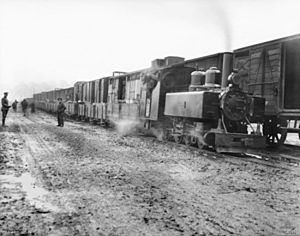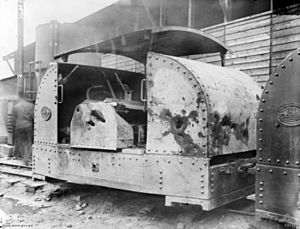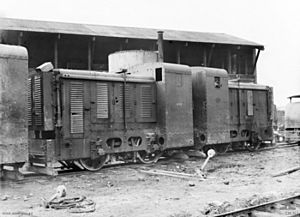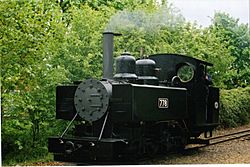War Department Light Railways facts for kids
The War Department Light Railways were a special system of small narrow gauge trench railways used by the British War Department during World War I. These light railways were super important for the Allied war effort. They helped move ammunition, supplies, and soldiers to the front lines. They also helped bring wounded soldiers back from the battlefield.
Contents
What are Track Gauges?
A track gauge is the distance between the two rails of a railway track. Different track gauges were used in different parts of the world during the war. Some common sizes were 600 mm (1 ft 11 5⁄8 in), 760 mm (2 ft 5 15⁄16 in), and 1,000 mm (3 ft 3 3⁄8 in) metre gauge.
In France, the military light railways mostly used a 600 mm (1 ft 11 5⁄8 in) gauge. This was also the size the Germans used for their own Feldbahn system. The Western Front of World War I had more small railway locomotives than anywhere else at that time!
How These Railways Developed
Britain soon realized it needed a quick and reliable way to get supplies to the front lines. They needed to bring shells, wood, and food from supply points further back. Small, narrow gauge light railways were the perfect answer.
Many companies built hundreds of locomotives for these lines. Some famous builders included Hunslet, Kerr Stuart, ALCO, and Baldwin. Even modified Model T cars were used! About 30 special companies were formed within the Royal Engineers to run these railways. Most of these railway workers were British, but soldiers from Australia, South Africa, Canada, and even an American unit also helped.
Each part of the front line had its own light railway to bring up materials. The British even used special train ferries to bring supplies directly from England to France. These ferries allowed whole trains to roll on and off!
By 1917, Canadian soldiers showed how useful these light railways could be. They had built many miles of new track in Canada before the war. Led by J. Stewart, they helped supply the Canadian Corps during their victory at Vimy. After this, the light railway system grew to 700 miles (1,100 km) of track. It could deliver 7,000 tons of supplies every day! As the war changed, tracks were built, rebuilt, and moved. By the end of battles like Passchendaele, Amiens, and Argonne, these light railways were key to the final victory.
WDLR Locomotives
A large number of locomotives were ordered for the WDLR. Most of them were 600 mm (1 ft 11 5⁄8 in) gauge.
Steam Locomotives
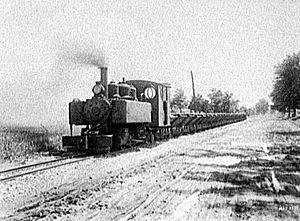
Here are some of the steam locomotives used:
- Hudson 0-6-0WT
- Barclay 0-6-0WT
- Hunslet 4-6-0T
- Baldwin Class 10-12-D 4-6-0T
- ALCO 2-6-2T
Internal Combustion Locomotives
These locomotives used petrol (gasoline) or petrol-paraffin engines:
- Motor Rail (Simplex) 20 hp (15 kW), petrol
- Motor Rail (Simplex) 40 hp (30 kW), petrol
- British Westinghouse 45 hp (34 kW), petrol-electric
- Dick, Kerr & Co. 45 hp (34 kW), petrol-electric
- Baguley 10 hp (7.5 kW), petrol-paraffin engine
Captured Locomotives
A few German feldbahn locomotives were also used by the British. However, they usually didn't last long because there were no spare parts to fix them.
Other Army Locomotives
The French Army and the U.S. Army also had their own locomotives for their light railways.
French Army Locomotives
- Decauville Progrès type 0-6-0T
- Pechot Bourdon 0-4-4-0T articulated locomotive
- Kerr, Stuart Decauville/Joffre type 0-6-0T+t
U.S. Army Locomotives
- Baldwin 2-6-2T
Preserved Locomotives Today
Many of these old locomotives still exist today! Some have been restored and can be seen running on special railways or in museums.
Baldwin Locomotives
The most famous war locomotives were probably the class 10-12-D type. Nearly 500 of these were built by the Baldwin Locomotive Works in the U.S. Many that survived the war found new homes around the world, especially in India. A few even came back to Britain after the war.
Four of these locomotives have been brought back from India to the UK. Two of them are fully working, and the other two are being restored.
Hunslet Locomotives
Hunslet 4-6-0 Locomotive no. 1215 (built in 1916) was brought back from Australia in 2008. It had worked on sugar cane railways there since 1924. Now, it's fully working at the Moseley Railway Trust's Apedale Valley Light Railway in the UK.
Another Hunslet 4-6-0 Locomotive, no. 1218 (from 1916), is now preserved at the Australian War Memorial in Canberra, Australia.
Hunslet 4-6-0 Locomotive no. 1229 (from 1916) is stored in Australia, waiting to be restored.
Hunslet 4-6-0 Locomotive no. 1239 (from 1916) was found in a park in Australia. It was restored and is now on display at the Rail Workshops Museum in Queensland, Australia.
Motor Rail Locomotives
After the war, many Motor Rail internal combustion locomotives were sold. They continued to work for decades on industrial narrow gauge railways, like the Leighton Buzzard Light Railway. The larger 40HP locomotives came in different versions: 'open', 'protected', and 'armoured'. It was quite interesting to see fully armoured locomotives working in factories!
| WDLR Number | Year built |
Works Number |
Type | HP | Notes |
|---|---|---|---|---|---|
| 264 | 1916 | 4wPM | 20 | Welsh Highland Heritage Railway | |
| LR2182 | 461 | 1917 | 4wPM | 40 | Armoured version. Greensand Railway Museum Trust |
| 507? | 1917 | 4wPM | 40 | "Mary Ann". Open type. Works number uncertain Ffestiniog railway (since 1923), and the first loco to run on the preserved Ffestiniog Railway (in 1954). | |
| LR3041 | 1320 | 1918 | 4wPM | 40 | Originally a protected version. Apedale Valley Light Railway. |
| LR3090 | 1369 | 1918 | 4wPM | 40 | Protected version. Apedale Valley Light Railway. |
| LR3098 | 1377 | 1918 | 4wPM | 40 | Protected version. National Railway Museum on loan to Leighton Buzzard Light Railway. |
| LR3101 | 1381 | 1918 | 4wPM | 40 | Protected version, restored as Open Version. Recently at Amberley Chalk Pits Museum |
| LR2478 | 1757 | 1918 | 4wPM | 20 | Apedale Valley Light Railway |
See also
- British military narrow-gauge railways
- Trench railways
- Light railway
- Railway Operating Division



